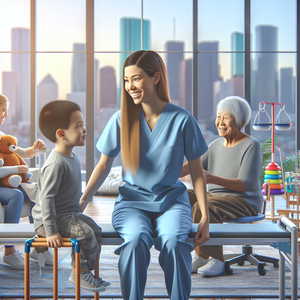The Future of Healing Hands: How AI and Robotics Enhance, Not Replace, Empathy in Occupational Therapy

Occupational Therapy Assistants (OTAs) occupy a unique and essential role in healthcare, working closely with patients to regain independence and improve quality of life after injury, illness, or disability. Their work goes far beyond assisting with physical tasks; OTAs foster emotional resilience and motivation, which are critical for recovery. Whether they are helping a stroke survivor relearn fine motor skills or guiding a child with developmental delays through sensory integration exercises, OTAs build relationships that inspire trust and confidence. Empathy forms the foundation of this connection. OTAs must understand their patients’ fears, frustrations, and triumphs to build a therapeutic bond. This emotional connection is integral to encouraging patients to persevere through the challenges of recovery. While AI excels at analyzing data and optimizing treatment plans, it lacks the ability to “connect” on a human level, making the hands-on, empathetic care provided by OTAs indispensable.
The Promise of AI and Robotics in Therapy
AI and robotics offer incredible potential to augment the work of OTAs, improving the quality and accessibility of care. For example, AI-powered software systems can analyze patient data to detect patterns, track progress, and predict recovery outcomes with remarkable accuracy. This data-driven insight allows OTAs to customize therapy plans for individual patients, optimizing the effectiveness of interventions. Wearable robotics, such as smart gloves or exoskeletons, are already enhancing therapy by assisting patients with precise, repetitive movements. These tools can help stroke patients regain motor skills or individuals recovering from surgery rebuild strength. Devices like the ArmeoSpring and other robotic therapy aids allow patients to practice movements in controlled, engaging environments, improving rehabilitation outcomes. Similarly, virtual reality (VR) tools are emerging as powerful therapy resources, enabling patients to practice real-world activities in safe, simulated settings. For instance, a person recovering from a traumatic brain injury might use VR to navigate a virtual grocery store, practicing cognitive and motor skills simultaneously. These technologies are not intended to replace OTAs but to serve as valuable allies. Robotics and AI can take over repetitive or physically demanding tasks, allowing OTAs to focus on the emotional and psychological care that only humans can provide. A robotic device may guide a patient through exercise, but it’s the OTA’s compassionate encouragement and personalized guidance that motivate the patient to keep going.
The Irreplaceable Human Touch
No matter how advanced AI or robotics become, they cannot replicate the adaptability, creativity, and emotional intelligence that OTAs bring to their work. Recovery is rarely a straightforward process, and patients often arrive at therapy sessions with unique needs, emotional states, and challenges. OTAs must think on their feet, adjusting their strategies to address the mental, emotional, and physical well-being of their patients. Consider a scenario where a patient becomes frustrated or overwhelmed during a session. While an advanced AI system might detect physiological signs of stress and adjust a machine’s resistance levels, it cannot offer a comforting smile, a motivational pep talk, or a listening ear. These moments of human connection provide emotional resilience, helping patients navigate the ups and downs of recovery. They are what make OTAs irreplaceable in the rehabilitation process. Moreover, the therapeutic relationship between OTAs and patients is not just a byproduct of care—it’s often the driving force behind a patient’s progress. Patients who feel understood, supported, and encouraged are more likely to stay engaged in their therapy, leading to better outcomes. This is a level of care that no machine, regardless of its sophistication, can replicate.
A Collaborative Future: OTAs and Technology as Partners
Rather than viewing AI and robotics as competitors, OTAs can embrace these tools as collaborators. By automating routine tasks, technology allows OTAs to focus on the aspects of care that require a human touch—empathy, adaptability, and emotional support. For example, while a robotic arm assists a patient with repetitive strength exercises, the OTA can engage the patient in conversation, assess their mental state, or provide encouragement to boost their confidence. Additionally, integrating AI and robotics into occupational therapy opens doors to new opportunities for OTAs. With training in emerging technologies, OTAs can become experts in using these tools to enhance patient care. They can leverage their understanding of human-centric therapy to ensure that AI and robotics are applied ethically and effectively. This collaboration could redefine the role of OTAs, positioning them as pioneers in a future where technology and humanity coexist seamlessly.
The future of occupational therapy is not a choice between technology and humanity—it is a collaboration between the two. AI and robotics have the potential to transform patient care, making it more efficient, precise, and accessible. However, these advancements cannot replace the empathy, creativity, and adaptability that OTAs bring to their work. As the healthcare industry continues to innovate, it is essential to strike a balance that prioritizes the human connection at the heart of healing. By embracing AI and robotics as tools rather than threats, OTAs can continue to provide compassionate, hands-on care while leveraging technology to enhance patient outcomes. This collaborative approach ensures that the future of occupational therapy remains firmly rooted in empathy, with technology serving as an ally in the journey toward recovery. In this way, the healing hands of OTAs will continue to play an irreplaceable role, even in an increasingly tech-driven world. The heart of occupational therapy will always lie in its human connections—connections that no machine can replicate or replace.
Rehabilitation Robotics Specialist
Ekso Bionics, Hocoma, or hospitals integrating advanced rehabilitation technologies
Responsibilities
Collaborate with occupational therapists to implement robotic devices (e.g., exoskeletons, smart gloves) in patient rehabilitation programs.
Train healthcare staff and patients on the safe and effective use of robotic therapy aids, such as the ArmeoSpring or robotic-assisted gait trainers.
Analyze patient data collected through robotic devices to refine therapy plans and track progress.
AI Integration Specialist for Healthcare Therapy
IBM Watson Health, Philips, or healthcare systems adopting AI solutions
Responsibilities
Design and implement AI-driven tools to enhance therapy workflows, such as predictive analytics for patient recovery timelines.
Collaborate with occupational therapists to customize algorithms for individual patient needs, ensuring ethical and patient-centered care.
Provide training sessions for therapy teams to effectively use AI-powered platforms for data analysis and personalized treatment planning.
Virtual Reality Therapy Developer
MindMaze, XRHealth, or startups focused on digital health innovation
Responsibilities
Create virtual environments for use in rehabilitation, such as VR simulations for patients recovering from cognitive or motor impairments.
Work with occupational therapists to design immersive therapy tools that mimic real-world scenarios, like navigating public spaces or performing daily tasks.
Conduct user testing with patients and therapists to ensure the VR tools are intuitive, engaging, and effective in recovery settings.
Occupational Therapy Technology Trainer
Large healthcare organizations and rehabilitation centers adopting cutting-edge technologies
Responsibilities
Educate occupational therapy teams on integrating advanced tools like wearable devices, robotics, and AI-driven platforms into patient care.
Develop training programs and materials tailored to therapists’ workflows, ensuring smooth adoption of new technologies.
Provide ongoing support and troubleshooting for therapy teams adapting to tech-enhanced practices.
Human-Centered AI Design Specialist
Google Health, Microsoft, or startups focusing on ethical AI in healthcare
Responsibilities
Work with healthcare professionals to design AI tools that prioritize human empathy and patient engagement, ensuring AI complements—not replaces—human care.
Conduct field research with occupational therapists to understand their workflows and design intuitive, therapist-friendly interfaces.
Advocate for ethical AI practices, ensuring algorithms respect patient privacy and autonomy while enhancing care delivery.


